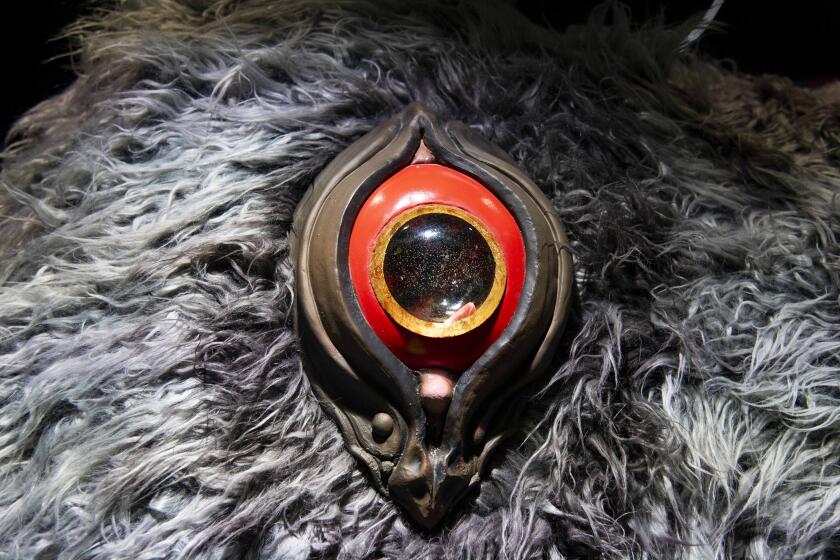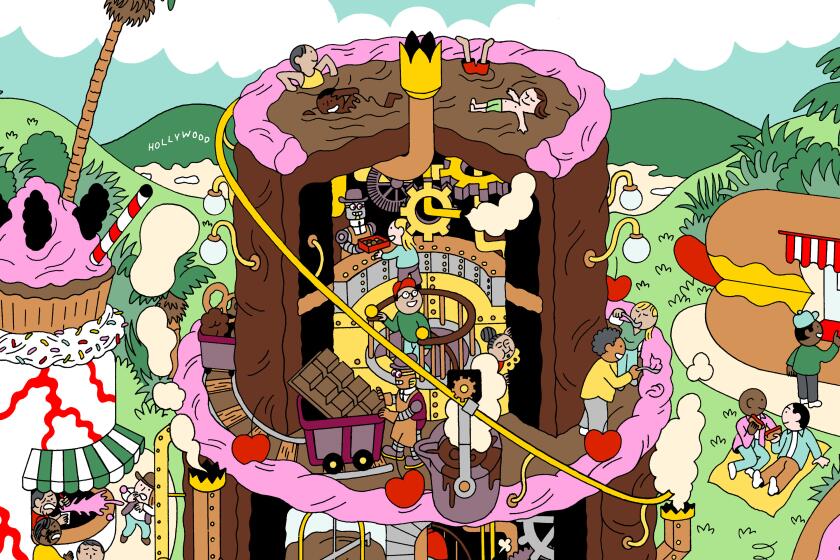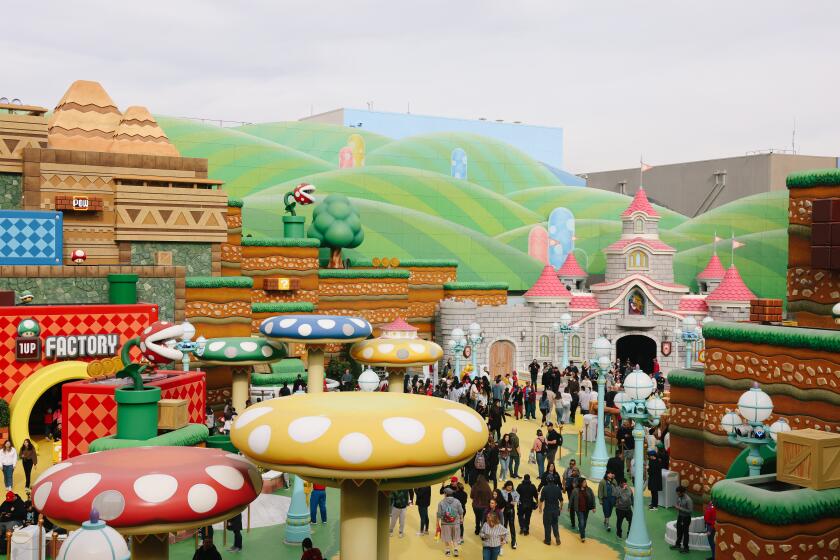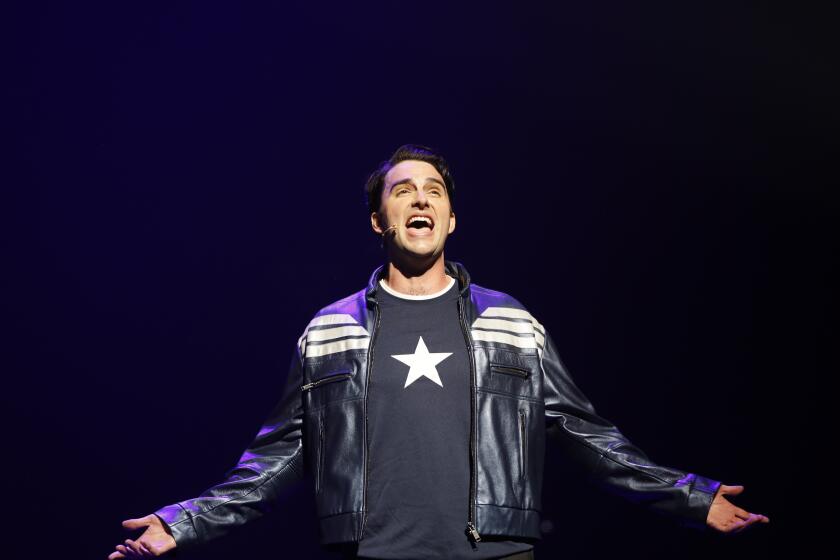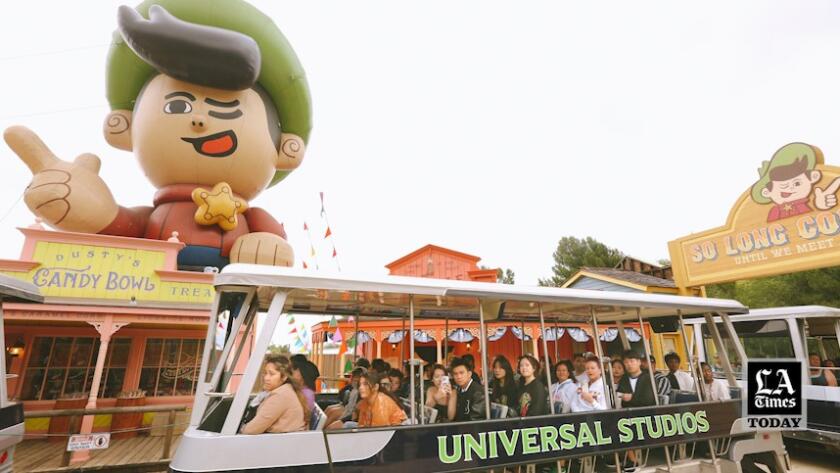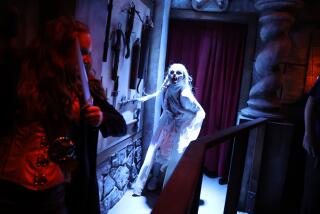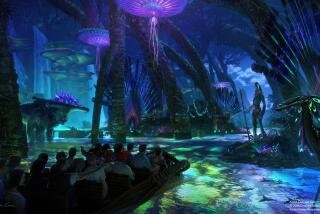(Thomas Bryson-King / For The Times)
- Share via
The Universal Studios tram tour — officially designated as the World-Famous Studio Tour — is today a polished theme park ride, a large-scale attraction bundled with a host of mini attractions within it. From a shark attack referencing Steven Spielberg’s “Jaws” to a jaunt through the fake rural amusement park of Jordan Peele’s “Nope,” the tour serves as a crash course in the last 50 years of Universal blockbusters, all while jostling park guests through a simulated earthquake and a 3-D encounter with King Kong.
It wasn’t always so burnished — or even a sure bet. “It was a pain in the ass, to be honest,” says Jay Stein, the now retired Universal Studios executive credited with turning the Studio Tour into the theme park force that it is today. Stein was asked to recall the reputation of the attraction when, a couple of years after it opened in the summer of 1964, he was tasked to lead it. “My recollection is that this is something that can’t really succeed.”
In 1964 the themed entertainment business was still in its infancy. While Disneyland had opened nine years earlier, other studios weren’t yet trying to replicate its success, and Stein, who had started in the mailroom, was seeking to work his way up the corporate film ladder. He had zero interest, in other words, in the amusement industry. Before being assigned the Studio Tour, Stein spent a good portion of his job trying to keep the tour out of the way of television productions. As historian Sam Gennawey writes in the Stein biography “JayBangs,” Stein had to quickly stop thinking of the tour as a nuisance and instead become its biggest champion.
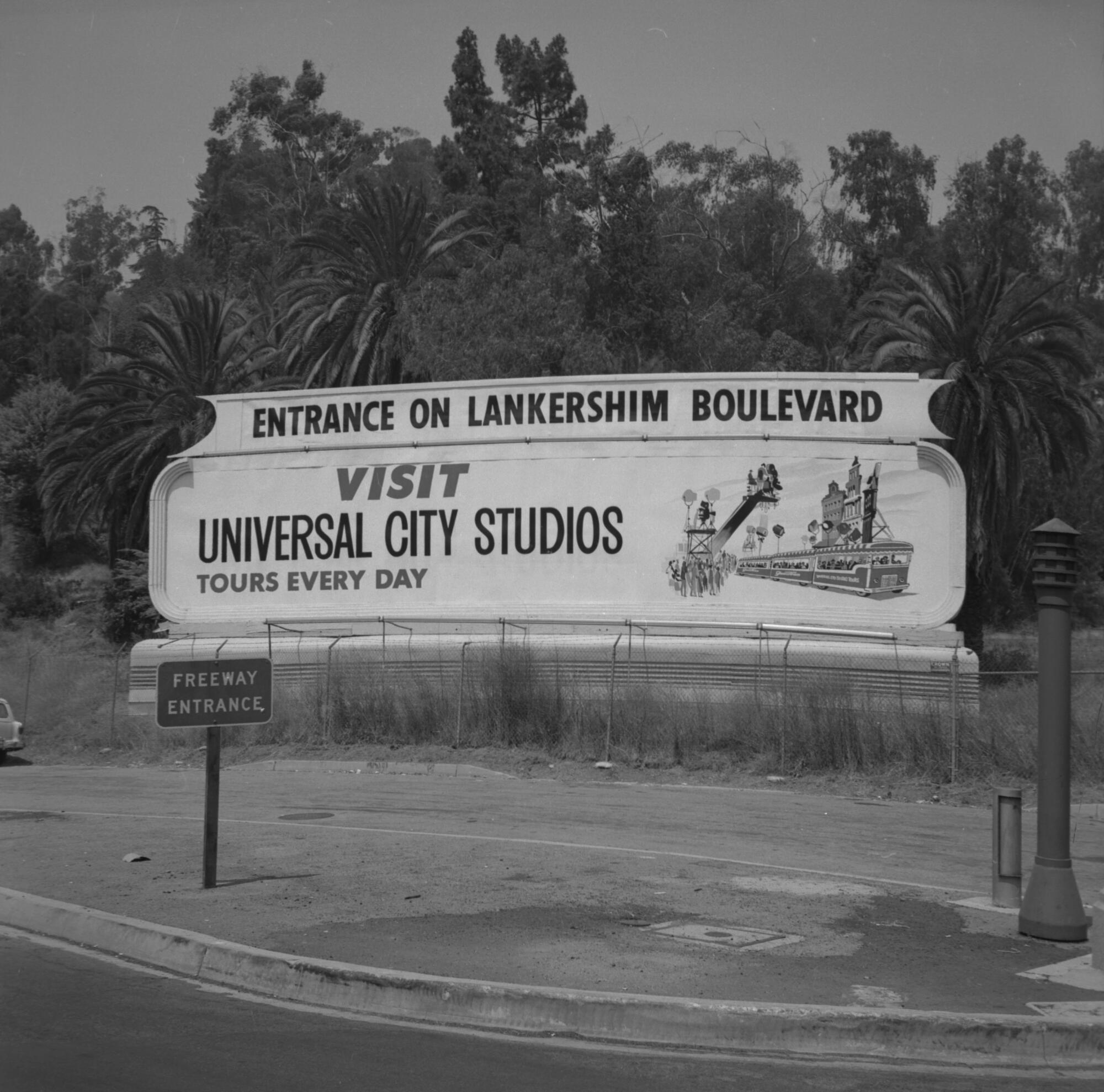
“It started out as two trams and a Quonset hut on Lankershim Boulevard,” says Stein, 86, today speaking from his home in Bend, Ore. “Quite frankly, the tram was considered something that interfered with television production and could not successfully coexist. I worked for the production office and was given the task of trying to coordinate how close we could come on the backlot without interfering. Everyone I worked for said it was an annoyance and disruptive and will not ever be welcomed.”
Within months, however, Stein began a makeover of the tram tour, one that would shift it from its behind-the-scenes, borderline educational focus to one that instead would be centered around light thrills and mechanical, movie magic tricks. By the mid-’70s, the Studio Tour would begin to reshape the modern theme park industry, not only ushering Universal into the field but recentering the entire medium as one that would be based around film and television franchises — intellectual property, or “IP,” in industry speak. The modern theme park would become a place to “ride the movies,” as Spielberg, who has long had a close relationship with Universal and its theme parks, branded them.
Today the Studio Tour is on the verge of 60 and still growing; Peele’s set from the sci-fi film “Nope” was the most recent addition. If Disneyland staples such as Pirates of the Caribbean, the Haunted Mansion and It’s a Small World set the template for what an attraction could be — heavily detailed dioramas that expand on a theme rather than a plot — it was the Studio Tour that would forever wed them to the popular media narratives of the moment. The Studio Tour and its accompanying shows would react, relatively quickly, to what audiences were responding to, be it “Battlestar Galactica,” “Conan the Barbarian,” “The Incredible Hulk” or more recently the “Fast & Furious” films and “Nope.”
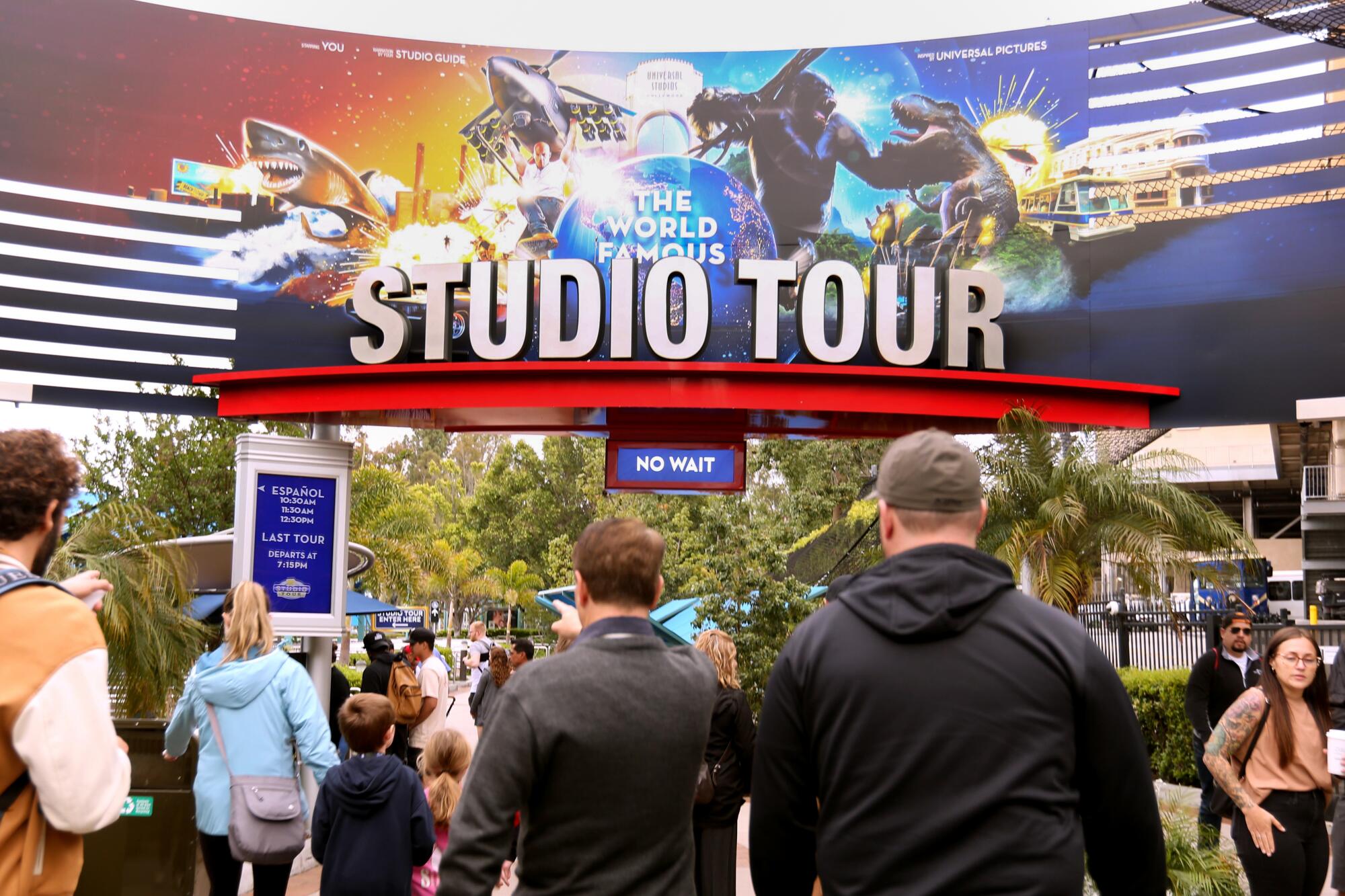
The Studio Tour is arguably the most important theme park attraction ever created. And remarkably, it earned that feat by being built in and around existing structures — and largely because Stein had two early revelations.
The first: A lack of control wasn’t going to cut it. “It was an industrial tour, and people always expected to see an actor or a production, and we couldn’t deliver on that,” Stein says. And even when they could, the latter two could be unpredictable. “When we park the tram 50 yards from a production, some of the shows that were taking place would say, ‘If we see a tram, we’re off the set. We’re gone.’” And as Gennawey notes, actor Shirley MacLaine is said to have once mooned a tram. “She kept her word,” Stein says today. “She said, ‘If I see another tram come by ... ‘“
The second: Studios are, well, kind of dull. A recent Studio Tour expressed as much, noting that the current labor strife in Hollywood has brought the studio’s backlot to a halt. “When a production was not there,” Stein says, “it looked dead, dusty and boring.”
The solution was clear: If the Studio Tour was going to be built to last, what started as a very real peek at how Hollywood worked would suddenly have to take after the industry it sought to glorify. That is, it would need to become a series of illusions.

Those who have studied the current Studio Tour like to point out that it’s not the first time Universal opened its gates to become a public showplace. Universal pictures founder Carl Laemmle welcomed fans in 1915 to watch how silent pictures were made. “He charged 25 cents, and they got a box lunch in the deal,” says John Murdy, known today as the architect of Halloween Horror Nights at Universal Studios Hollywood. Murdy, who started at Universal as a tram tour guide before graduating to theme park design, has become something of a Universal historian.
“They erected bleachers so they could watch these outdoor filming stages,” Murdy says. “And there was a zoo on the property at the time, so they could tour the zoo. That went on until the late 1920s and the early 1930s, until sound came in.”
But different eras bring different financial motivations. The modern Studio Tour is rooted in a more basic human desire: We need to eat.
In the early 1960s, according to Stephen M. Silverman’s book “The Amusement Park,” Universal began welcoming Gray Line Tours onto the studio lot for their Hollywood history jaunts. The primary goal was to boost the bottom line of the studio commissary, where Gray Line guests would stop for lunch. “When they saw the commissary was making a lot of money,” says Murdy, “that was the literal seed,” and mogul Lew Wasserman allowed his staff to investigate the feasibility of running its own tour.
Universal’s tour had its grand opening on July 15, 1964, with a media rep later downplaying to The Times its goals, stating that the tour was a “public relations gesture on the part of the studio” and the aim was to simply break even. But this paper had an immediate fan in gossip columnist Hedda Hopper, who noted that tourists finally had a glimpse of Hollywood that went beyond “looking at a bunch of footprints in concrete.” Within two years, Universal was reporting that 8,000 guests per day were riding the so-called GlamorTrams, which were accentuated with candy-striped accouterments designed by Disneyland planner and famed set designer Harper Goff.
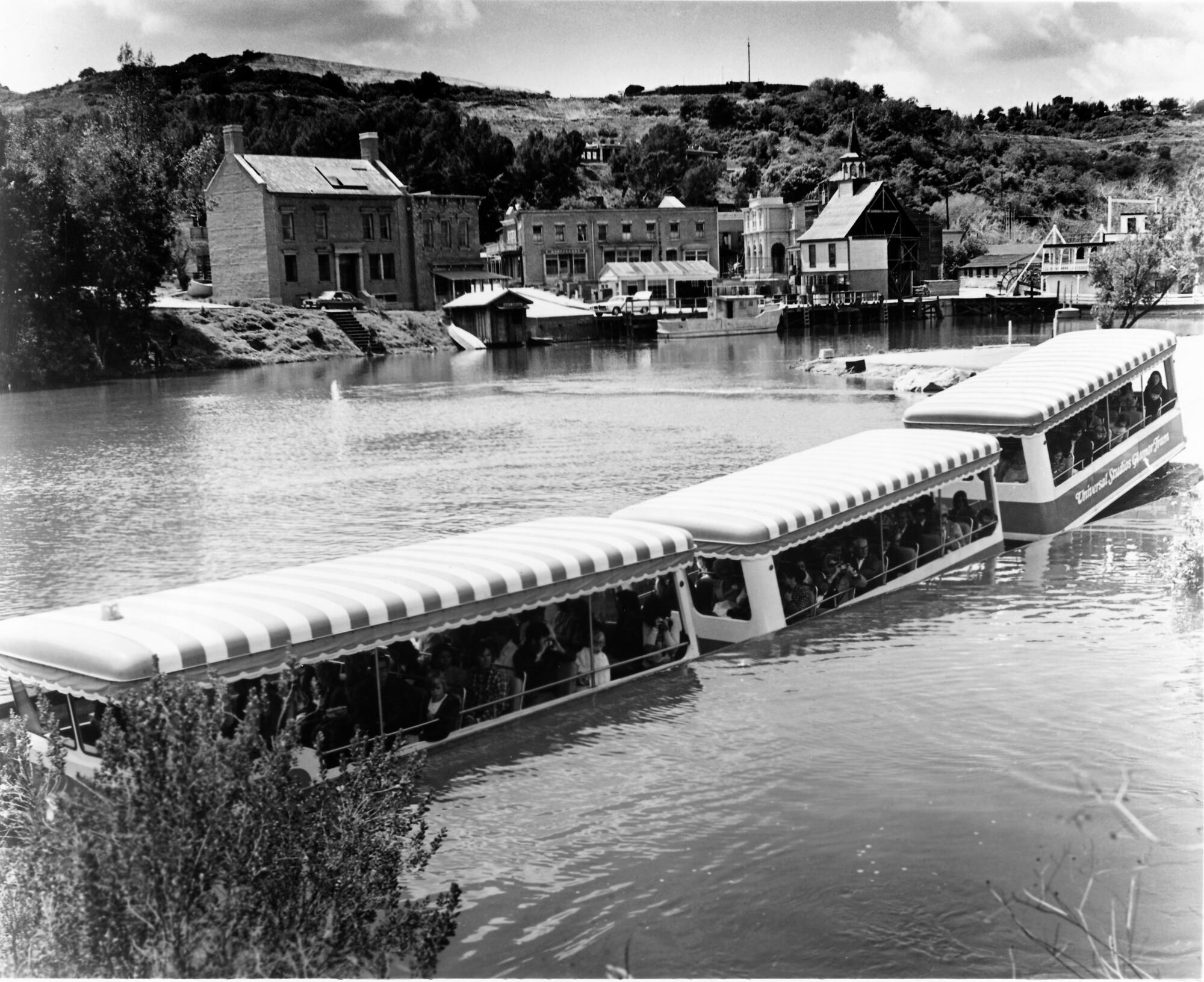
Within a year, The Times noted that Universal was experimenting with stunt shows on the tour, and by 1966 the tour was offering guests makeup demonstrations, artificial snowstorms and miniature sea battles at an upper lot concourse. Albert A. Dorskind, president of parent company MCA, soon telegraphed the studio’s ambitions, telling The Times in 1968 that he envisioned Universal becoming a Tivoli Gardens-like concept centered around entertainment, referencing the famed Copenhagen park.
Stein was the man to realize that vision, and he began experimenting around that time with a flash flood on the tram tour, in which a rush of water leaps multiple feet into the air before quickly dissipating before the tram. The flash flood is still a part of the tour today.
“The geography was there,” Stein says. “What the hell could we do with this dead-ass street and involve the audience with something other than looking at an inactive, sterile set? That’s how I came up with the flash flood. ... The problem with it, which we had no idea at that time, is in a movie you do one or two takes and throw it away. We had to build something that could be done every two or three minutes. How do you involve a tram full of people in something where you create a thrill? It was really crude and simple, and if you did something like that today it’d be like old-time movies, but that stuff was done 55 years ago and is still working because it makes a dull set exciting.”
Other illusions would follow, including a parting of the Red Sea, a collapsing bridge, an ice tunnel, a rock slide and a submarine attack — “generic stuff,” says Stein, before the tour had rights to various film and television properties. The upper lot — the second half of the tour, in which guests were allowed to freely wander — also began to expand its show offerings, creating screen tests and animal shows in addition to stunt demonstrations.
Not all of the experiments of Stein and his team, however, made the history books.
“There was one that I never understood,” Murdy says, “and I have pictures of this so I know I didn’t make it up in my child mind. There was a section by the black lagoon where they filmed some Tarzan movie. And they had a gorilla, like Tarzan, on a rope, and we’d hear the Tarzan yell but it was a gorilla. It was not Tarzan. He would swing along the side of the tram, and he was holding a severed arm in his hand. I have no idea why, but I actually have a picture. I have a picture of this from way back in the ’70s. Those were mostly done in house by the special effects teams. There wasn’t an industry yet.”
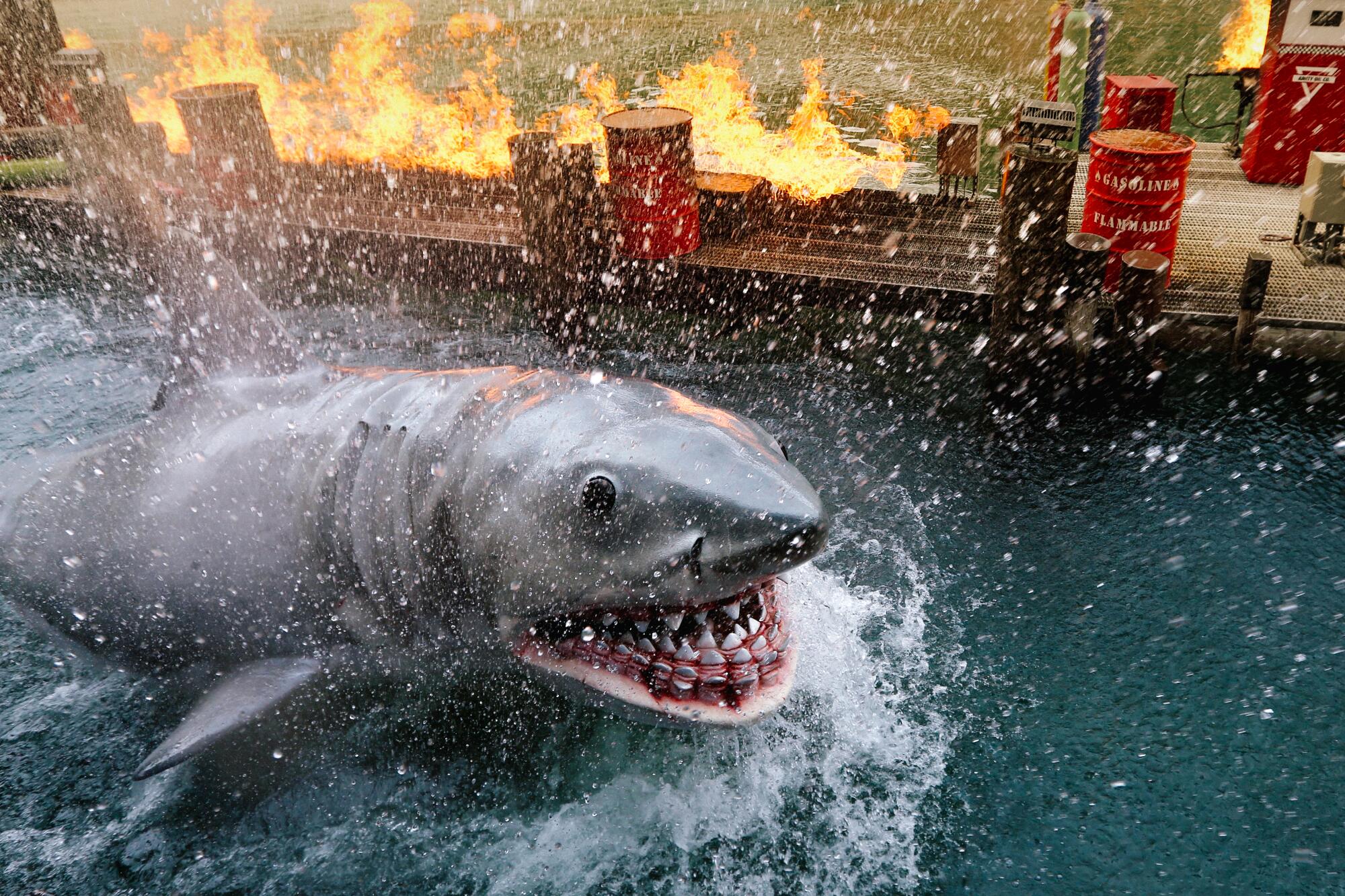
Everything changed in 1976. That was one year after Spielberg’s “Jaws” opened and when the Studio Tour built a mini re-creation of an Eastern seaboard waterfront and put guests face-to-face with a 24-foot shark. It was expensive to build and maintain, as The Times noted in 1977 that the shark required $250,000 per year in maintenance. Stein says the company even sought the help of submarine builders General Dynamics to understand how to create things to last in water.
“Jaws” forever changed the tenor of the tour, and arguably theme parks. While Disneyland had roots in the company’s animated fairy tales, especially in Fantasyland, and early attractions took cues from the studio’s “True-Life Adventures” and films such as “Swiss Family Robinson,” nothing on the level of the cultural phenomenon that was “Jaws” had so quickly been replicated in a theme park before. It’s an industry-wide trend that hasn’t stopped.
“With the addition of a ‘Jaws’ experience, guests were brought face to face with an angry shark as well as fire and water explosions, and for the first time immersed in an experience based on a blockbuster movie property,” says Phil Hettema, who runs a namesake themed-entertainment firm in Pasadena and is a veteran of Universal Creative and the Studio Tour.
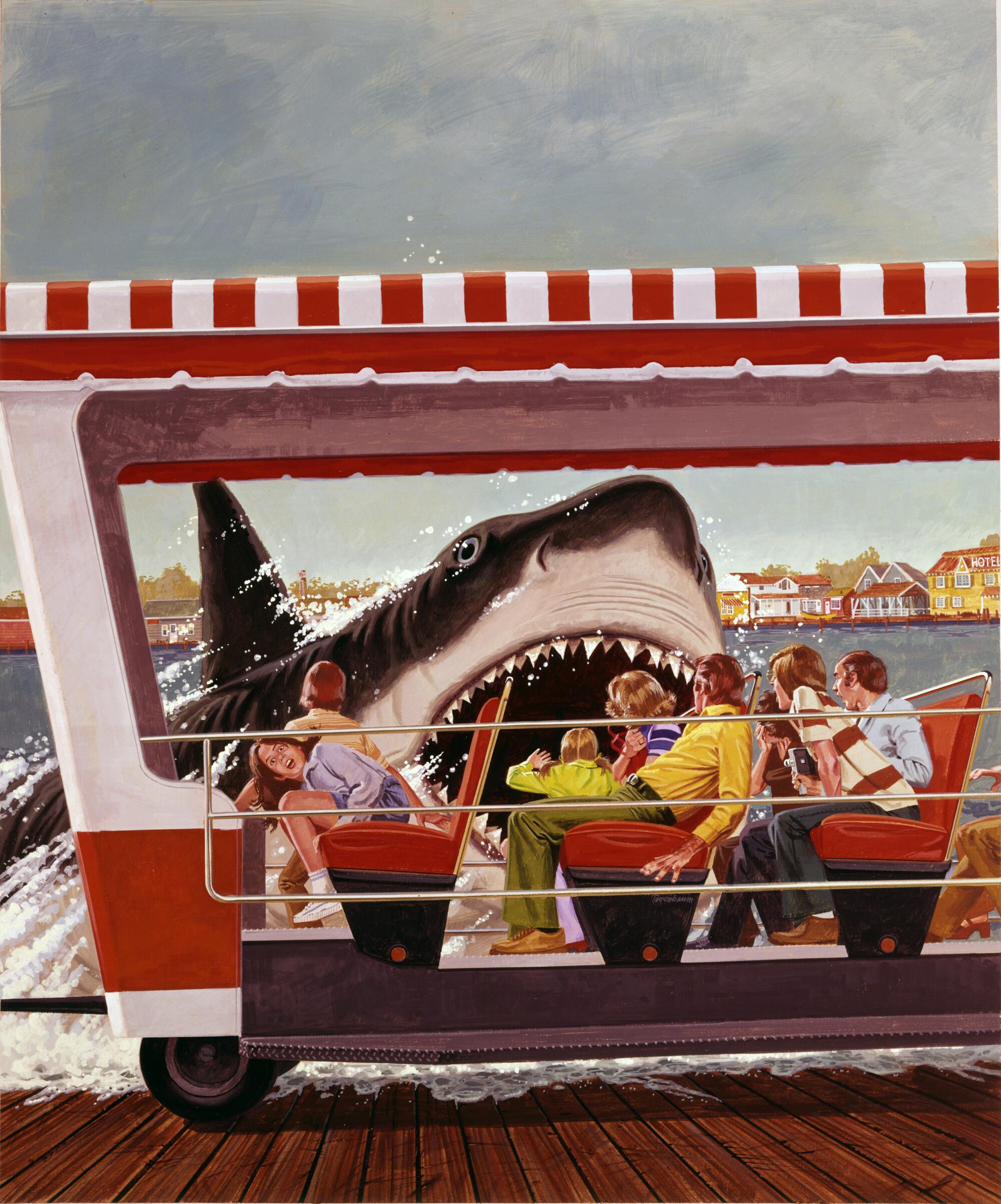
There’s gleeful pride in Stein’s voice when recollecting the “Jaws” scenes, especially in their grown-up weirdness. One moment, for instance, has the shark attacking a stationary diver and the lagoon filling with fake blood. “That’s the stuff that works,” Stein says. “The blood. By adding things that enhance the effect, that is what puts a ride over the top. No one expects when the shark is coming up that we’re going to drop the tram a foot toward the water. That scares the hell out of you. That’s what I lived for, to make this thing come alive.”
Stein and Universal were then emboldened to bring in nods to other properties, and by 1977 the tour was bringing in $25 million in revenue. “Battlestar Galactica,” “Conan the Barbarian,” “The Incredible Hulk” and more were soon added to the tour and its upper lot attractions. While the expansive theme park attraction E.T. Adventure, in which guests would simulate riding flying bikes through a darkened show building, wouldn’t come to Universal Studios Hollywood until 1991, Murdy says the beginnings of the theme park were well solidified.
“Battlestar Galactica was kind of the first big theme park-style attraction that was incorporated into the tour,” he says. “You pulled into a show venue and with live actors and animatronics the scene played out. And lasers. It was impressive. They were really shooting laser beams.”
Not everything needed to be so intense. The Hulk experience, for instance, was relatively simple, with the muscled green man simply appearing at unexpected moments — crashing, The Times reported, a makeup show, or careening through a fake stone wall at other points on the tour. “That’s a show that I think we spent $50,000 on the whole thing,” Stein says. “It’s a muscle man painted green. We got a huge bump in attendance because ‘The Incredible Hulk’ was seen by millions of people. It was no more than a guy busting through a wall. I never came up with something that was so inexpensive that was so effective.”
So much so that Universal — and those who visited its parks — began dreaming big.
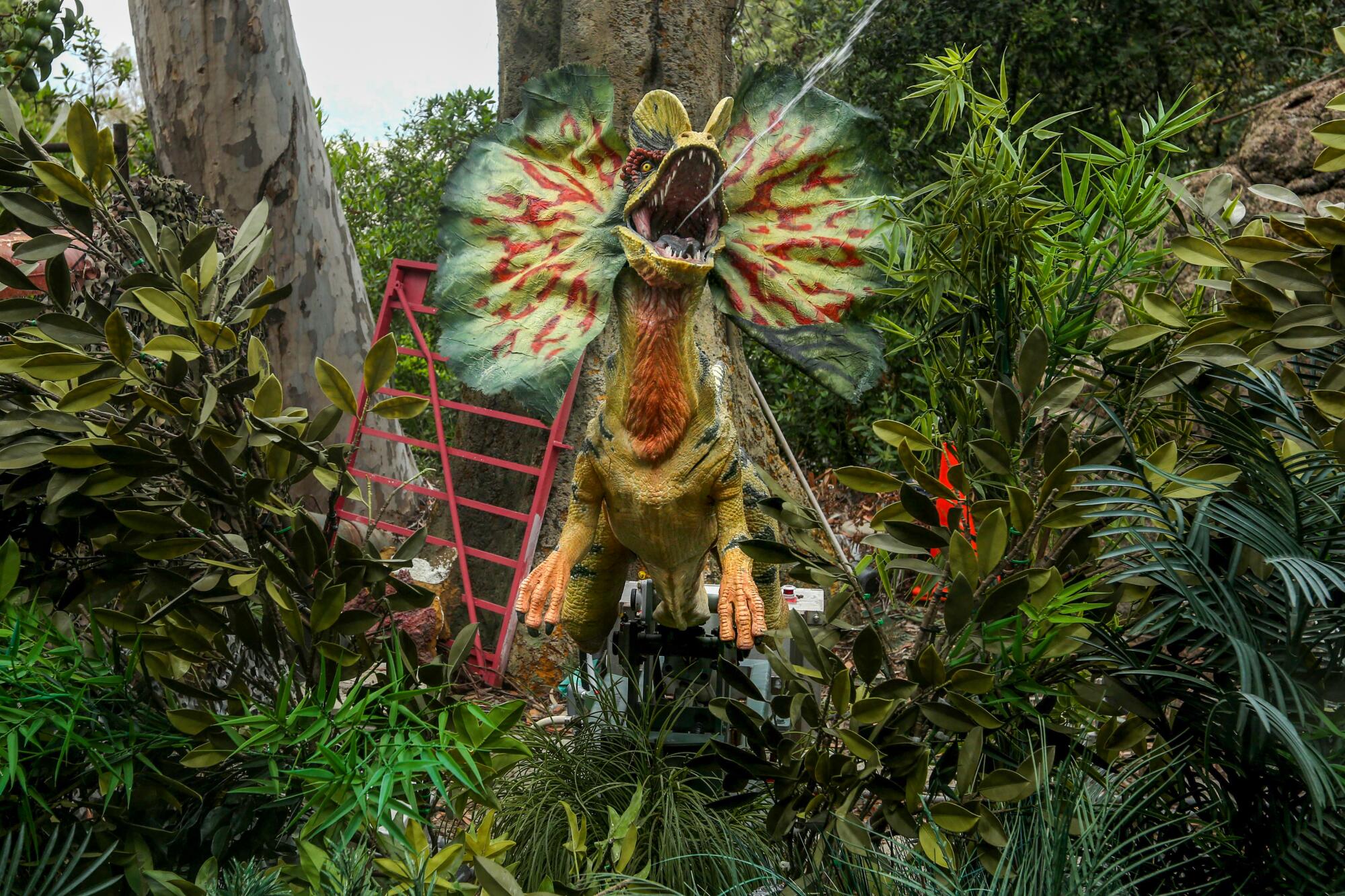
When “Nope” filmmaker Jordan Peele first made it to a Universal Studios park in Florida, it fueled, he says, a lifelong obsession.
“It was something very aspirational and magical,” Peele says. “I was told we didn’t have enough money to go to Disneyland or Universal, and at some point we got an opportunity because my mother’s job was doing something in Florida. I remember going to both places, and Universal Studios in Orlando, I remember it creating more magic for me than the other park.
“I went to very few amusement parks growing up, so when I got to Universal at 11 or 12 years old, it was formative in reinforcing my love of film,” Peele says. “It had a ‘Willy Wonka’ aspect of a world that had been opened to me that now I could sort of see behind the wall of it. Even though a lot of it is illusion, the illusion of getting to be in the presence of what it means to make movies was an addiction I never got over.”
The ’80s was a period of growth for the Hollywood Studio Tour, never more so than via the additions of a 30-foot tall King Kong animatronic that was added in 1986 (and destroyed in a 2008 fire) and an earthquake simulation in 1989, the latter of which pushed attendance to more than 30,000 people a day.
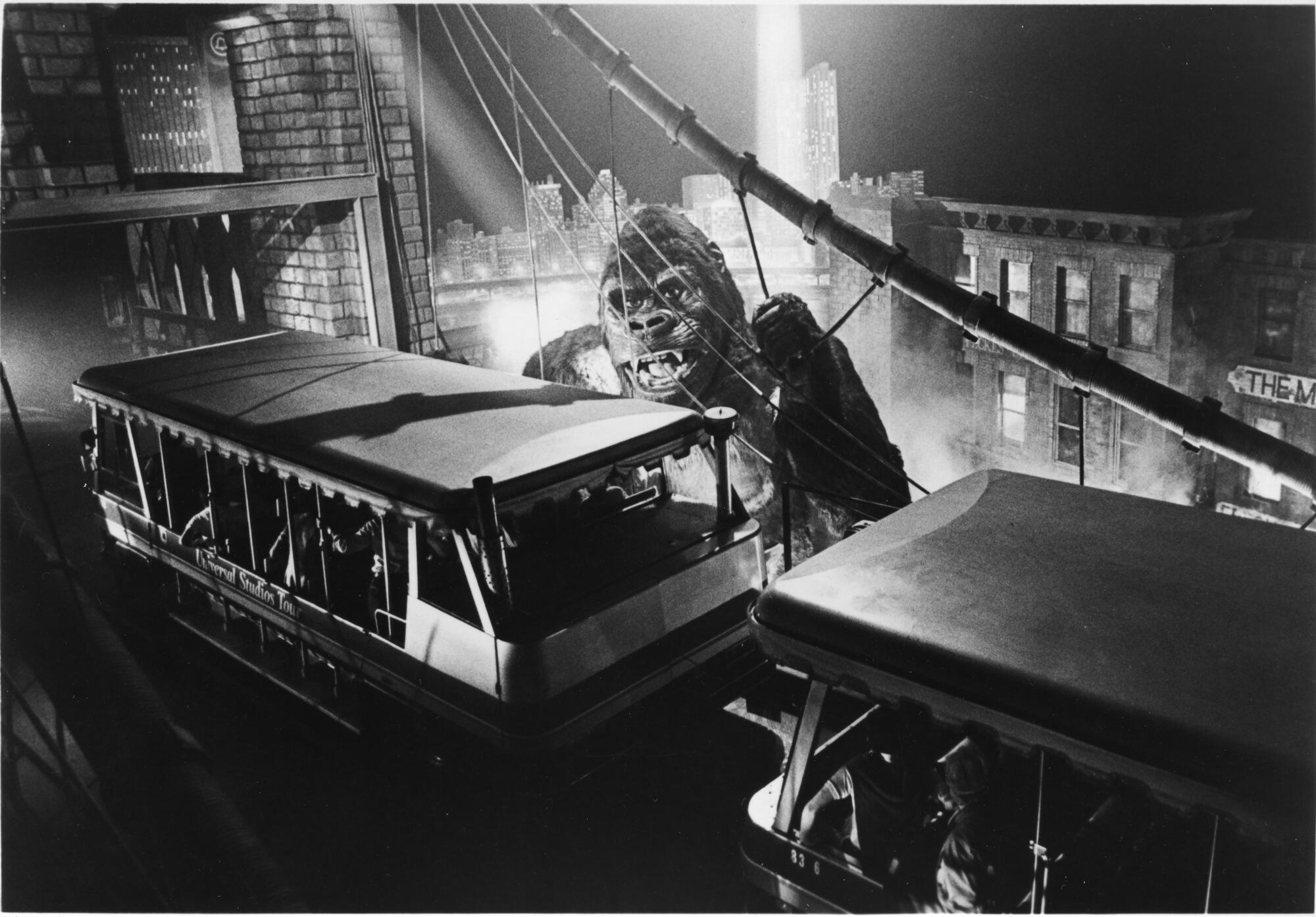
“Starting with ‘King Kong,’ guests found themselves on the tram in the midst of a completely immersive environment with a larger-than-life animated ape,” Hettema says. “Not only was the environment impressive, but, significantly, the tram vehicle itself rocked from side to side and slid across the roadway — physically engaging the guests.
“It was a hit with guests that continued with ‘Earthquake,’ where the total immersion of guests on the tram was taken to new heights — putting the guests in an illusion of danger and thrill that was visceral by physically shaking, sliding and dropping the tram. The tram could be considered the first motion base vehicle, now a key component of the most popular immersive attractions throughout the industry.”
The decade, however, was also a period of great stress for Stein. Buoyed by the success of the increased theme parkification of the Studio Tour, Universal began to look at expansion into Florida, resulting in the park that would eventually catch Peele’s heart. But when Universal Studios Florida opened in 1990, it did so after nearly a decade-long battle with the Walt Disney Co.
It’s a well-documented, often-told tale, and one that’s too large for this story to encompass, but Universal wasn’t shy in alleging that Disney stole its Florida plans for the park that would today be known as Disney’s Hollywood Studios. The latter opened in 1989 with, for instance, a tram tour that was very much in the Universal model. While Disney has long denied the contentions of Universal and its then-parent, MCA, Stein didn’t hold back, telling The Times in 1989 that “Disney took what we had, and we had to fish or cut bait,” explaining that Universal shifted from a tram-focused park to one based instead on stand-alone attractions.
Today, the subject still gets Stein worked up, and his colorful descriptions of Disney are not fit for print. “They did the same thing, and we had to up our game,” Stein says today. “If anything pissed me off more in life than that, I don’t know what it is. We knew what they were going to do. They were going to do what we wanted to do, so we upped our game in every show, every set, every stage, every element.”
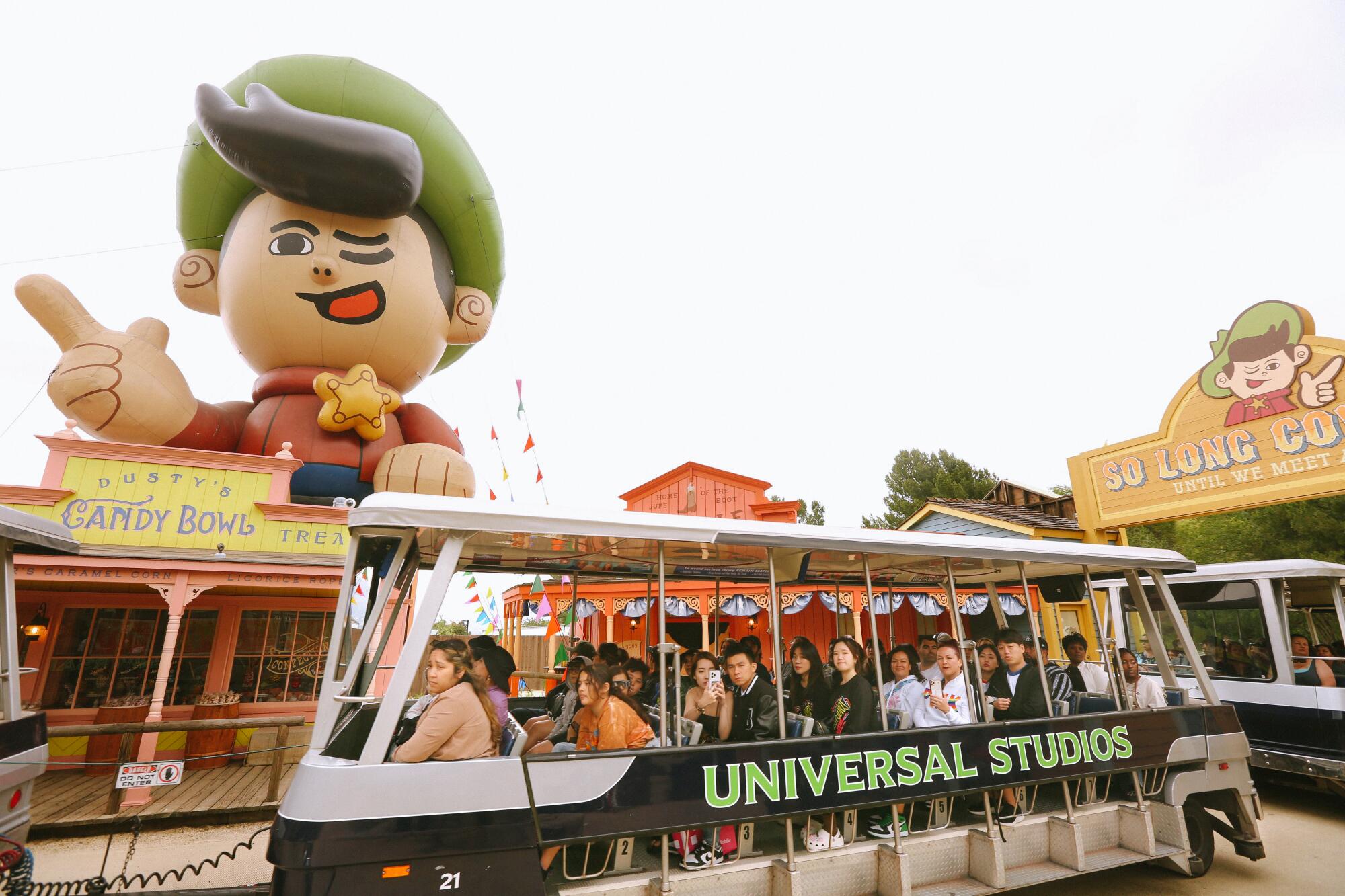
The Florida project benefited the original Studio Tour and park. The earthquake attraction was duplicated, albeit in different formats, on each coast, and remains one of the most elaborate — and frightening — attractions on the West Coast. Additionally, the park’s relationship with Spielberg would tighten. Although an E.T. attraction no longer exists in Hollywood, it’s still alive in Florida, and Spielberg’s “Jurassic Park” franchise is not only a part of the Studio Tour but received a stand-alone, water-based attraction.
When it came to competing with Disney, Stein says, Spielberg brought a level of respectability to the Universal parks. “The opportunity to get Spielberg as a creative consultant gave us a credibility,” Stein says. “Nobody had heard of Jay Stein, but that was as much a contributory factory to our success as anything. He delivered the goods.”
“Movies bring us together from all walks of life to hear good stories,” Spielberg wrote via email. “Many of these stories are themed and can make deep and lasting impressions. Theme parks, like Universal’s, bring the memories of these stories into three dimensional life. In 1989 when I coined the term ‘ride the movies,’ it still stands as one of the main reasons people descend on our theme parks to be part of those stories in a real world way.”
The Studio Tour remains the backbone of the Universal theme parks, the impetus for its expansion and the home to relatively constant renovations.
Last year, the Studio Tour took in the set of the fictional Gold Rush-themed amusement park of Jupiter’s Claim from “Nope.” It was Peele who reached out to the theme park and asked if it might be interested in the set. “That’s right,” Peele says. “If you can’t tell from my personality or my films, I’m very into memorabilia and objects and cars and sets from films. It’s very hard when a film is done to take something [down] that I believe is something that people will want to experience in the future.”
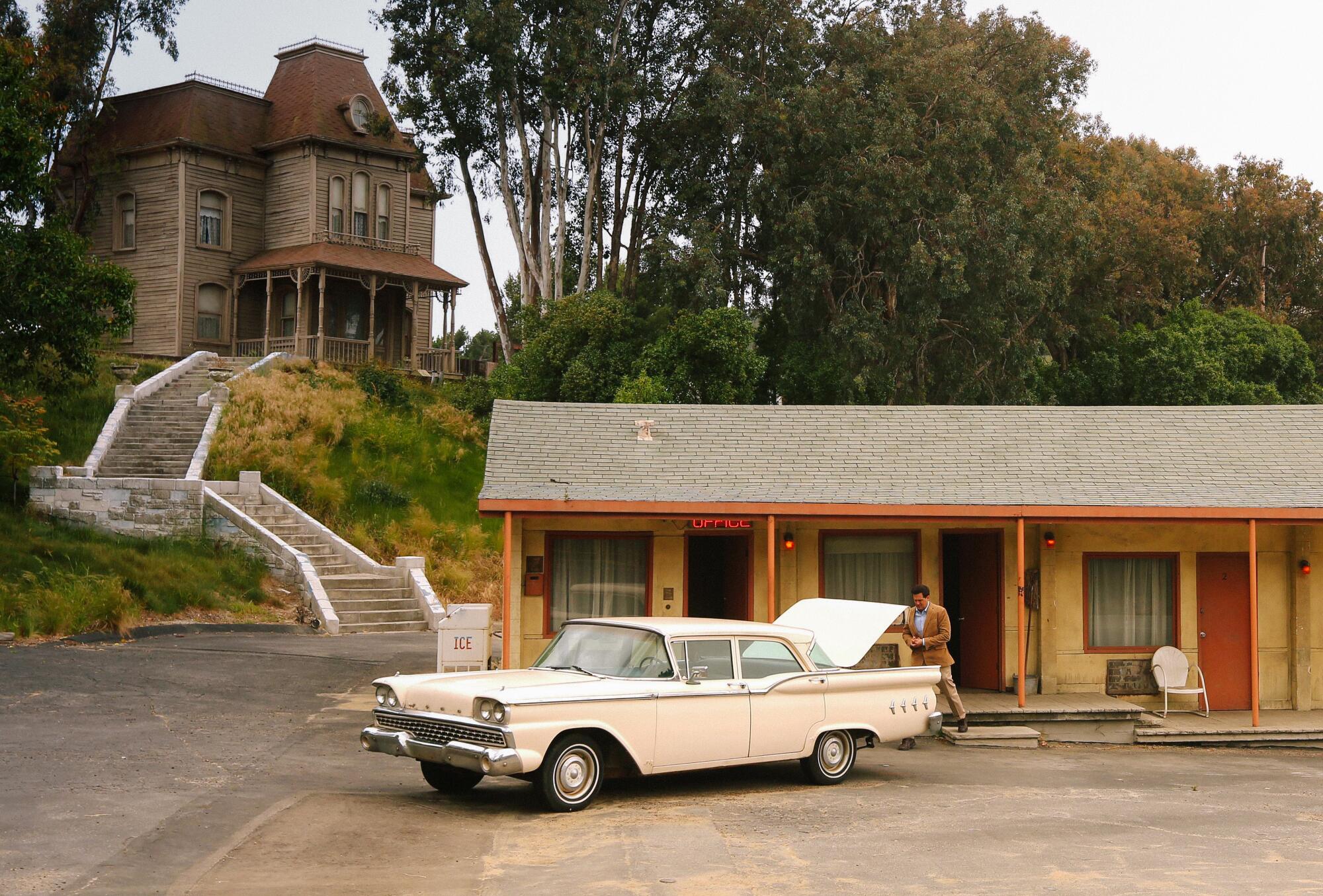
That it’s part of the Studio Tour, Peele says, has helped cure some of his impostor syndrome. “Steven Spielberg and Alfred Hitchcock, these were figures that helped inspire me to not compromise in the commitment to the bigness of the audience’s experience,” Peele says. “So for a piece of [‘Nope’] to end up among ‘Jaws’ and ‘Psycho’ on this tram tour, you can see how a kid who felt like he was an impostor for even stepping into the gates, it’s a full circle sense of accomplishment. ... Believe me, I have some humility, but the character of making that film was not humble. It was meant to be a film that people would want to be on the set. Let’s presume ourselves next to ‘Jaws.’”
Productions once tried to hide from the Studio Tour; today, they ask to be a part of it. The Studio Tour, in execution and in reputation, is a long way removed from attempting to scare guests with the rubber boulders of a fake rock-slide, all in an effort to increase lunch sales.
“There was enough pressure that could have been brought to kill this thing,” Stein says of the tour’s mid-’60s beginnings. “Because who needs this interruption on a daily basis so you can have a small profit at the end of the year? The commissary was losing money, so the tourists would be allowed to eat at 3 p.m. in the commissary. It was small potatoes and not anything that would have shown at that time any indication that it was going to have the growth potential that I ultimately saw. It reinvigorated me.
“This little thing,” Stein continues, “had the potential to be very special.”
A first look at Meow Wolf’s latest wonderland in Texas, which plants the company’s progressive flag in a red state with a message that art can break barriers.
Dinner with a robot assist? Toothsome Chocolate Emporium at Universal Studios’ CityWalk is a popular weekend reservation. Will it revive themed restaurants?
‘Super Mario Bros.’ creator Shigeru Miyamoto on the importance of play: A visit with the game design mastermind at Universal Studios’ Super Nintendo World.
‘Rogers: The Musical,’ Disney’s new Captain America-inspired musical, started as a joke in a Disney+ series and now is part of the resort’s big summer offerings.
- Share via
Watch L.A. Times Today at 7 p.m. on Spectrum News 1 on Channel 1 or live stream on the Spectrum News App. Palos Verdes Peninsula and Orange County viewers can watch on Cox Systems on channel 99.
More to Read
The biggest entertainment stories
Get our big stories about Hollywood, film, television, music, arts, culture and more right in your inbox as soon as they publish.
You may occasionally receive promotional content from the Los Angeles Times.
